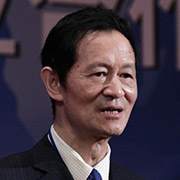China’s GDP grew at 7.8% during H1, 2012, breaking the 8% psychological barrier, with Q2’s rate as low as 7.6%, the sixth consecutive quarterly slowdown. This fact has elicited panicked responses in the European and American media, and plenty of worry in China. The Wall Street Journal on July 13 predicted that China would drag the world economy into “another recession”. A commentary in Die Frankfurter Zeitung of Germany titled “The fear of China crash” on the same day even warned that China is faced with a catastrophic economic crash. Some voices within China also worry about the continuous slowdown and a possible hard landing; appealing for all necessary policy actions to sustain the 8% GDP growth rate for the whole year of 2012. However these dire reports mischaracterize the current state of the Chinese economy.
China’s Economic Slowdown is No Cause for Alarm
7.8% Growth is Right on Track
It must be remembered that the Chinese government set this year’s growth target at 7.5%. Even if the economy continues to grow at a rate of 7.6% in H2, the whole year will hit an average 7.7% growth rate. China’s 12th five-year-plan (2011-2015) envisaged an annual growth rate of 7%. Hence, if 2012 has a growth rate of 7.6%, the economy needs only to grow by 6.4% per annum during 2013-2015. Previously, the 8% growth rate was a “red line” for China during the Asian financial crisis in 1997-1999, and world financial crisis in 2009. It is, however, no longer the case now, as China is shifting its focus from rapid economic growth to a more sustainable development model.
By examining a breakdown of the three driving forces of the Chinese economy during H1, 2012, one can better understand the current economic slowdown.
First is the decline in fixed investment within China. Fixed investment only grew by 20.4% y-o-y, or 5.2 percent lower than it did in H1 2011. The main contributing factors to this slower growth rate were declining real estate investment (only 16.6% vs. 32.9% in H1, 2011) and decreased railroad construction (down by 36.9%). The former has been the result of strict controls aimed at quenching speculation and bubbles, while the latter shows a necessary adjustment after exceptionally high growth in previous years. However, fixed investment in other industrial sectors still grew by 23.8%, a fast rate. Total volume of fixed investment hit Rmb 15,071bn, 66.4% of total GDP, still the world highest. These two changes, combined with impressive industrial fixed investment, are actually healthy signs for the Chinese economy.
The second economic driver is domestic consumption. Recently released numbers show that total retail volume was up 14.4% over a year ago. With a much lower CPI rate, the real growth rate hit 11.2%, 3.4 percent higher than GDP growth. Another indicator of domestic consumption, auto sales, was also up 9.1%. This shows that consumption is growing fast; a good sign as Beijing attempts to rebalance the economy away from export driven growth towards more domestic consumption.
Third is foreign trade. There was a sharp downturn in H1, against the backdrop of the European Debt crisis and vulnerable world economic recovery. Total imports and exports grew by a mere 8.0% y-o-y, as compared to a growth rate of 25.8 % in H1, 2011. The net export downturn was a major factor dragging down the total Chinese economy. As the recent policy actions by the central government are gradually implemented during the second half of this year, a modest rebound is expected. GDP slowdown is likely to bottom out during Q3, returning to 8% in that quarter and slightly higher than 8% during Q4, thus bringing the whole year growth rate to around 8%. Needless to say, no recession is on the horizon, let alone a potential “crash”.
Limited Impact on the US Economy
Recently, China’s imports grew by only 6.7%, even more slowly than its exports during H1, 2012. However, imports from the US grew by 7.9%, slightly higher than from the rest of the world. It is, nonetheless, sharply down from the 21.2% growth during H1, 2012. This has led to a reasonable worry in the US that the slowdown in the Chinese economy may further affect the American NEI aimed at doubling the export volume in 5 years, and thus affect American employment and industry rebuilding.
However, an empirical study of previous Chinese economic downturns and US exports to China has found that US exports to China did not necessarily slow down even in poor years. During the Asian financial crisis of 1997-1999, China’s GDP grew at 9.3%, 7.8% and 7.6% respectively. US exports to China grew by an aggregate 25.8% during the subsequent 3 years of 1998-2000, while her exports to the world grew by only 13.4%. During the recent world financial crisis of 2009, US exports to the world fell by 18.0%, while US exports to China only fell by a tiny 0.3%. The author is cautiously optimistic about US exports to China for the latter half of this year, as data indicates they were picking up during Q2 already. With a poor Q1 start, growing by only 2.1% (y-o-y), Q2 saw the growth rate sharply higher at 16.4%. With a modest economic rebound and the US import push policy working, US exports to China should have two-digit growth for the whole year.
Facts also show that the US economy has been driven mostly by domestic personal consumption and private fixed investment. These two factors combined contributed 1.76 percentage point to US GDP growth (3.0%) in 2010, 2.34 percentage points in 2011 (GDP growth at 1.7%), and 2.48 percentage points in Q1, 2012 (GDP grew at 1.9%), while net exports of goods and services contributed only minus 0.51, 0.05 and 0.10 percentage points respectively. Different from Japan and Germany, exported goods account for only 10% of GDP in the US. US goods to China, in turn, account for only 7% of the US total goods exported. Hence, the impact of Chinese economic slowdown on the US economy will be limited.
Given the statistics above and the make up of the US economy, the numbers also belay another criticism the US increasingly makes against China. There has been a continuous, raucous bashing of China in the US during the current election year, amid the high jobless rate and weak economic recovery, blaming China’s trade policy for “taking away American jobs” as a key root cause of the current US economic malaise. However, one can easily find it unfounded simply by reading the official US labor statistics. The total US non-farm sector added 1.777 million jobs from June 2011 to June 2012, a 1.35% increase. There was also an increase of 1.64% in the US goods producing sector, and 1.91% in the manufacturing sector. This shows that the sectors producing internationally tradable products have an above the average job growth rate. Jobs in the auto and parts sector shot up by 8.8%, although there is a heated complaint on fast imports from China. Job losses, on the other hand, happened in information services (down 1.54%), and government (down 0.76%). Finance and insurance barely had any growth coming in at 0.35%. It is worth mentioning that all these sectors, information services, government, finance, and insurance, are not internationally tradable.
In the end, the Chinese economy should be viewed as on the cusp of a much needed transition, not an impending crash. China’s current GDP growth rate is holding steady to the targets set for this year. Fixed investment in certain sectors has slowed to cool inflated sectors of the economy while still improving in others. Foreign trade will rebound once the global economy picks up and hopefully expand given China’s increased emphasis on greater domestic consumption. It is important that the US recognize that this rebalancing will have a limited effect on the US recovery while potential exists for mutual gain by both countries. The US should try to avoid overblown campaign rhetoric as evidenced by the Olympic team uniform outcry in this crucial time. Only through mutual cooperation and respect can the Chinese and US both improve their economies.
He Weiwen is the co-director, China-US/EU Study Center at the China Association of International Trade
You might also like
- Peter Bittner Editorial Assistant, The Diplomat
- Hua Xin PhD candidate, CASS Graduate School
- Peng Gui Graduate Student, Johns Hopkins School of Advanced International Studies
- Niu Tiehang Senior Fellow, CCIEE
- Zhang Monan Senior Fellow, China Int'l Economic Exchanges Center




